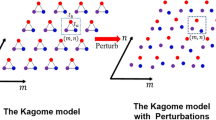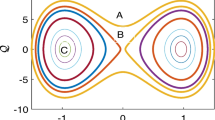Abstract
The time taken by a wave packet to cross through a finite-layered PT-symmetric system is calculated by stationary phase method. We consider the PT-symmetric system of fix spatial length L consisting of N units of the potential system ‘\({+}\,iV\)’ and ‘\({-}\,iV\)’ of equal width ‘b’ such that \(L=2Nb\). In the limit of large ‘b’, the tunneling time is found to be independent of L and therefore, the layered PT-symmetric system displays the Hartman effect. The interesting limit of \(N \rightarrow \infty \) such that L remains finite is investigated analytically. In this limit, the tunneling time matches with the time taken to cross an empty space of length L. The result of this limiting case \(N \rightarrow \infty \) also shows the consistency of phase space method of calculating the tunneling time, despite the existence of controversial Hartman effect. The reason of Hartman effect is unknown to present day; however, the other definitions of tunneling time that indicate a delay which depends upon the length of traversing region have been effectively ruled out by recent attosecond measurements.




Similar content being viewed by others
References
L. Nordheim, Proc. R. Soc. A 119, 173 (1928)
R.W. Gurney, E.U. Condon, Nature 122, 439 (1928)
E.U. Condon, Rev. Mod. Phys. 3, 43 (1931)
E.P. Wigner, Phys. Rev. 98, 145 (1955)
D. Bohm, Quantum Theory (Prentice-Hall, New York, 1951)
T.E. Hartman, J. Appl. Phys. 33, 3427 (1962)
J.R. Fletcher, J. Phys. C 18, L55 (1985)
H.G. Winful, Phys. Rep. 436, 1–69 (2006). and references therein
V.M. Aquino, A. Navarro, M. Goto, H. Iwamoto, Phys. Rev. A 58(6), 4359 (1998)
V.S. Olkhovsky, E. Recami, G. Salesi, Euro. Phys. Lett. 57, 879 (2002)
S. Esposito, Phy. Rev. E 67, 016609 (2003)
S. Kudaka, S. Matsumoto, Phys. Lett. A 375, 3259 (2011)
V. Milanovic, J. Ranovanovic, Phys. Lett. A 376(16), 1401 (2012)
S. Kudaka, S. Matsumoto, Phys. Lett. A 376, 1403 (2012)
P. Pereyra, Phys. Rev. Lett. 84(8), 1772 (2000)
F. Raciti, G. Salesi, J. Phys. I EDP Sci. 4(12), 1783 (1994)
A. Paul, A. Saha, S. Bandopadhyay, B. Dutta-Roy, Euro. Phys. J. D 42, 495 (2007)
A. Ghatak, M. Hasan, B.P. Mandal, Hartman–Fletcher effect for array of complex barriers. arXiv:1505.03163
M. Hasan, B.P. Mandal, Tunneling time from locally periodic potential in space fractional quantum mechanics. arXiv:1902.00381
A.M. Steinberg, P.G. Kwiat, R.Y. Chiao, Phys. Rev. Lett. 71, 708 (1993)
G. Nimtz, H. Spieker, H.M. Brodowsky, Phys. Lett. A 222, 125 (1996)
P. Balcou, L. Dutriaux, Phys. Lett. A 78, 851 (1997)
L. Ragni, Phys. Rev. E 79, 046609 (2009)
F. Sattari, E. Faizabadi, AIP Adv. 2, 12123 (2012)
S. Longhi, M. Marano, P. Laporta, M. Belmonte, Phys. Rev. E 64, 055602 (2001)
C. Olindo, M.A. Sagioro, F.M. Matinaga, A. Delgado, C.H. Monken, S. Padua, Opt. Commun. 272, 161 (2007)
S. Longhi, P. Laporta, M. Belmonte, E. Recami, Phys. Rev. E 65, 046610 (2002)
U.S. Sainadh, H. Xu, X. Wang, A.A. Noor, W.C. Wallace, N. Douguet, A. Bray, I. Ivanov, K. Bartschat, A. Kheifets, R.T. Sang, I.V. Litvinyuk, Nature 568, 75 (2019)
A.P.L. Barbero, H.E. Hernandez-Figueroa, E. Recami, Phys. Rev. E 62(6), 8628 (2000)
E. Recami, F. Fontana, R. Garavaglia, Int. J. Mod. Phys. A 15, 2793 (2000)
V.S. Olkhovsky, E. Recami, Phys. Rep. 214(6), 339 (1992)
V.S. Olkhovsky, E. Recami, F. Raciti, A.K. Zaichenko, J. Phys. I 5, 1351 (1995)
G. Privitera, G. Salesi, V.S. Olkhovsky, E. Recami, LANL Archives #. arXiv:cond-mat/9802126
V.S. Olkhovsky, E. Recamib, J. Jakielc, Phys. Rep. 398, 133 (2004)
C.M. Bender, PT Symmetry in Quantum and Classical Physics (World Scientific, Singapore, 2019)
M.V. Berry, Czech J. Phys. 54, 1039 (2004)
W.D. Heiss, Phys. Rep. 242, 443 (1994)
A. Mostafazadeh, Phys. Rev. Lett. 102, 220402 (2009)
A. Ghatak, R.D. Ray Mandal, B.P. Mandal, Ann. Phys. 336, 540 (2013)
C.F. Gmachl, Nature 467, 37 (2010)
W. Wan, Y. Chong, L. Ge, H. Noh, A.D. Stone, H. Cao, Science 331, 889 (2011)
N. Liu, M. Mesch, T. Weiss, M. Hentschel, H. Giessen, Nano Lett. 10, 2342 (2010)
H. Noh, Y. Chong, A. Douglas Stone, Hui Cao, Phys. Rev. Lett. 108, 6805 (2011)
A. Mostafazadeh, M. Sarisaman, Proc. R. Soc. A 468, 3224 (2012)
M. Cai, O. Painter, K.J. Vahala, Phys. Rev. Lett. 85, 74 (2000)
J.R. Tischler, M.S. Bradley, V. Bulovic, Opt. Lett. 31, 2045 (2006)
S. Dutta Gupta, Opt. Lett. 32, 1483 (2007)
S. Balci, C. Kocabas, A. Aydinli, Opt. Lett. 36, 2770 (2011)
A. Mostafazadeh, Ann. Phys. 375, 265 (2016)
S. Longhi, J. Phys. A Math. Theor. 44, 485302 (2011)
A. Mostafazadeh, Phys. Rev. A 87, 012103 (2013)
F. Loran, Opt. Lett. 42, 5250 (2017)
L. Deak, T. Fulop, Ann. Phys. 327, 1050 (2012)
M. Hasan, B.P. Mandal, Ann. Phys. 396, 371 (2018)
B. Dutta Roy, Elements of Quantum Mechanics (New Age Science Ltd., New York, 2009)
D.J. Griffiths, C.A. Steinkea, Am. J. Phys. 69(2), 137 (2001)
M. Hasan, B.P. Mandal, Ann. Phys. 391, 240 (2018)
Acknowledgements
MH acknowledges supports from Director-SSPO for the encouragement of research activities. BPM acknowledges the support from MATRIX project (Grant No. MTR/2018/000611), SERB, DST Govt. of India.
Author information
Authors and Affiliations
Corresponding author
Appendix
Appendix
Consider that the transfer matrix M, of a ‘unit cell’ potential is known,
such that,
where \(A_{+}, B_{+}\) are the coefficients of the asymptotic solution of the scattering wave to the right of the potential (Eq. 8) and \(A_{-}, B_{-}\) are the coefficients of the asymptotic solution of the scattering wave to the left of the potential (Eq. 9). Then, the transmission coefficient (for incidence from left) of a periodic system made by n repetitions of the ‘unit cell’ is given by
where
Here \(s=w+g\), where w is width of the ‘unit cell’ potential and g is the gap between consecutive ‘unit cell’ potentials. For the present problem, \(w=2b\) and \(g=0\), thus \(s=2b\). The procedure to derive Eq. 51 is outlined in [56]. A caution note for the reader is, in [56], the transfer matrix considered is \(M^{-1}\); however, the procedure to arrive at Eq. 51 is the same as detailed in [56]. From Eq. 18, the \(M_{11}\) and \(M_{22}\) elements of our ‘unit cell’ PT-symmetric system are
Using Eqs. 15 and 16 in Eq. 53, the \(M_{11}\) element can be simplified to
In the above, we have essentially separated the term \(P_{+}^{1} P_{+}^{2}-S^{1}S^{2}\) in real and imaginary parts to arrive at Eq. 55. The expression for \(\xi \) and \(\chi \) is given by Eqs. 21 and 22, respectively. Next, we simplify \(M_{22}\) element using Eqs. 15 and 16 in Eq. 54. It is easy to show that
We observe \(M_{22}=M_{11}^{*}\) which implies that the argument, \(\zeta \) of Chebyshev polynomial is real. We substitute Eqs. 55 and 56 in Eq. 52. This gives \(\zeta = \xi \). Substituting Eq. 56 and \(\zeta =\xi \) in Eq. 51, our final expression of transmission coefficient \(t_{n}=t\) is given by
where \(G(k)=(\xi -i\chi ) U_{N-1}(\xi )-U_{N-2}(\xi )\) (Eq. 20). In Eq. 57, we have identified \(ns=2Nb=L\), where L is the net spatial extent of our layered PT-symmetric system.
Rights and permissions
About this article
Cite this article
Hasan, M., Mandal, B.P. Hartman effect from layered PT-symmetric system. Eur. Phys. J. Plus 135, 84 (2020). https://doi.org/10.1140/epjp/s13360-019-00084-1
Received:
Accepted:
Published:
DOI: https://doi.org/10.1140/epjp/s13360-019-00084-1




